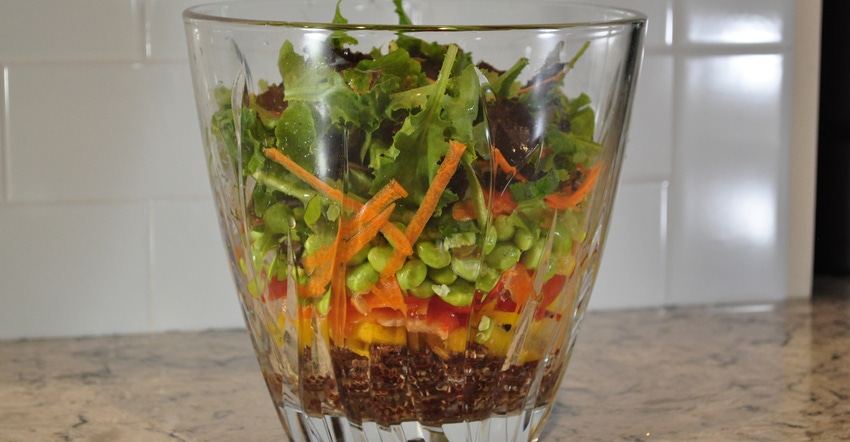June 19, 2020

Remember hearing about the “freshman 15” when you went to college? The joke now is that the freshman 15 has turned into the “COVID 19” for many of us working at home with such easy access to the pantry and fridge.
Except it’s not funny when you step on the scale.
It’s time to get back to basics and use this shelter-at-home to adopt some healthier habits. I’ve got three tips that I’m adopting in my life: Eat more slowly, go to bed earlier and postpone cravings.
1. Do you eat too quickly? I blame grade school. We gobbled our lunch so we could get to recess. It’s a habit we haven’t given up, but we need to. We are seemingly rushing everywhere — rushing to finish work, rushing to get dinner on the table, then rushing through dinner to get to bed and get up … and do it all over again.
Observational research published in a recent medical journal showed a strong association between how quickly we rush through meals and obesity and waist circumference. In the study, almost 60,000 Japanese patient records were reviewed. Participants had their waist circumference, body mass index and labs measured at checkups while answering questions about lifestyle behaviors, including eating speeds rated as fast, normal or slow. Those who ate at a normal rate were 29% less likely to be obese, while slow eaters were 42% less likely to carry excess pounds. And slow eaters also had the smallest waist.
Slowing down when we eat allows the brain to register a feeling of fullness. That process can take up to 20 minutes.
2. Are you getting enough sleep? Sleep lows and our metabolism go hand in hand and are connected to how we view food. When we’re tired, we tend to make poor food choices. Research finds lack of sleep stimulates appetite-promoting effects, which imbalance our gut bacteria; this causes an unhealthy metabolism, which can eventually lead to obesity. The study finds that even a healthy individual who is sleep-deprived will choose larger portions, increase food consumption based on impulse decisions and expend less energy throughout the day.
3. Saying “later” to cravings gives us willpower. A joint study at Erasmus University and the University of Houston invited 100 undergrad volunteers to watch film previews. Students were divided into three groups. Each group had a bowl of chocolate candies in front of them. Group 1 was told to wait to eat the candy; Group 2 was encouraged to snack in moderation; Group 3 was invited to eat all they wanted. By waiting, Group 1 ate 70% less than Group 3 and 58% less than Group 2. Researchers found the behavior of those in Group 1 carried over in the following week. So, try delaying that chocolate chip cookie for a while.
Here’s a great recipe to get started on your healthy eating plan. It’s a twist on the usual seven-layer salad. Layer it in a trifle bowl to impress your family.
Seven-Layer Vegetable and Quinoa Salad
1 cup uncooked quinoa
2 cups vegetable stock or chicken broth, unsalted
1 cup red bell pepper, seeded, cut into thin strips
1 cup yellow bell pepper, seeded, cut into thin strips
1 cup thinly sliced carrots, divided
1 cup frozen shelled edamame, thawed
½ cup chopped fresh parsley
1 package (5 ounces) fresh salad blend
Ginger-Apple Dressing
½ cup orange juice
¼ cup apple juice
1 tablespoon apple cider vinegar
1 tablespoon finely chopped fresh ginger
1 teaspoon lime juice
Salt and pepper, to taste
To make the dressing, combine all ingredients in a small jar with a secure lid. Shake well. Season to taste with salt and fresh ground pepper. Refrigerate any unused dressing. Makes about ¾ cup.
Cook quinoa in stock or broth according to package directions. Once cooked, remove from heat and set aside. Set 1 tablespoon of carrots aside to toss later with salad blend. Using a 6- to 8-inch-tall trifle bowl or straight-sided glass bowl, begin layering ingredients, starting with quinoa. Continue by layering bell peppers, remaining carrots, edamame and parsley. Season each layer with salt and pepper, if desired. Lightly toss salad blend with reserved 1 tablespoon of carrots and one-third of the dressing; neatly place on top. Serve the remaining dressing on the side. Serves 4.
Per serving: 250 calories, 12 grams protein, 42 grams carbohydrate, 4.5 grams fat, 7 grams fiber
Fargo is a registered dietitian with Southern Illinois University Medical School in Springfield, Ill. Send recipe ideas to her at [email protected]. The opinions of this writer are not necessarily those of Farm Progress/Informa.
About the Author(s)
You May Also Like






